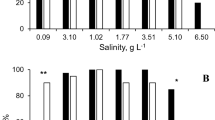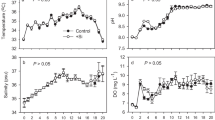Abstract
The effect of different total dissolved solid levels (TDS) was investigated as a predictor of diapause induction in the calanoid copepod Aglaodiaptomus leptopus. We collected adult copepods in the field and monitored seasonal changes in diapause egg production. We determined total dissolved solid levels, conductivity and temperature values from five ponds. In experimental work, females bearing clutches, collected from the field, were monitored under laboratory conditions to determine the extent of diapause induced. Females without clutches were placed with males and then subjected to low, medium and high TDS levels. After six days, females bearing clutches were isolated to determine the proportion of clutches that were diapausing. The relationship between TDS and food levels was calculated using Williamson and Butler’s food limitation index (f). We concluded that neither TDS nor temperature are predictors of the induction of diapause in this study. The obtained results suggest, however, that density possibly plays a role in predicting diapause induction.
Similar content being viewed by others
References
Ban S. and Minoda T. 1994. Induction of diapause egg production in Eurytemora affinisby their own metabolites. Hydrobiologia 292/293: 185–189.
Castro-Longoria E. and Williams J.A. 1999. The production of subitaneous and diapause eggs: a reproductive strategy for Acartia bifilosa(Copepoda: Calanoida) in SouthamptonWater, UK. J. Plankton Res. 21: 65–84.
Danks H.V. 1987. Insect Dormancy: An Ecological Perspective. Biological Survey of Canada Monograph Series No. 1
De Stasio B.T. 1989. The seed bank of a freshwater crustacean: copepodology for the plant ecologist. Ecology 70: 1377–1389.
Edmondson W.T. (ed.) 1959. Freshwater Biology 2nd edition. John Wiley and Sons, New York, New York, USA.
Gonzalez C.R.M. and Bradley B.P. 1994. Salinity stress proteins in Eurytemora affinis. Hydrobiologia 292/293: 461–468.
Hairston N.G. Jr. and Kearns C.M. 1995. The interaction of photoperiod and temperature in diapausing timing: a copepod example. Biol. Bull. 189:42–48.
Hairston N.G. Jr. and Olds E.J. 1984. Population differences in the timing of diapause adaptation in a spatially heterogeneous environment. Oecologia 61: 42–48.
Hairston N.J.Jr. and Olds E.J. 1986. Partial photoperiodic control of diapause in three populations of the freshwater copepod Diaptomussangoineus. Biol. Bull. 171: 135–142.
Hairston N.G. Jr. and Olds E.J. 1987. Population differences in the timing of diapause: a test of hypotheses. Oecologia 71: 339–344.
Hutchinson G.E. 1967. A Treatise on Limnology. Vol. 2, John Wiley and Sons, New York, New York, USA.
Marcus N.H. 1980. Photoperiodic control of diapause in the marine calanoid copepod Labidocera aestiva(Copepoda: Calanoida). Biol. Bull. 162: 39–44.
Marcus N.H. 1982. The reversibility of subitaneous and diapause egg production by individual females of Labidocera aestiva(Calanoida: Copepoda). Biol. Bull. 162: 39–44.
Marcus N.H. 1984. Variation in the diapause response of Labidocera aestiva(Copepoda: Calanoida)from different latitudes and its importance in the evolutionary process. Biol. Bull. 166: 127–139.
Piercey D.W. and Maly E.J. 2000. Factors influencing the induction of diapausing egg production in the calanoid copepod Diaptomus leptopus. Aquat. Ecol. 34: 9–17.
Reid G.K. 1961. Ecology of Inland Waters and Estuaries. Van Nostrand Reinhold Company, New York, New York, USA.
Stross R.G. 1996. Significance of photoperiodism and diapause control in the multicycle crustacean Daphnia pulexLeydig. Hydrobiologia 320: 107–117.
Walton W.E. 1985. Factors regulating the reproductive phenology of Onchyodiaptomus birgei(Copepoda: Calanoida). Limnol. Oceanogr. 30: 167–179.
Watras C.J. and Haney J.F. 1980. Oscillations in the reproductive condition of Diaptomus leptopus(Copepoda: Calanoida) and their relation to rates of egg-clutch production. Oecologia 45: 94–103.
Watson N.H.F. and Smallman B.N. 1971. The role of phoyoperiod and temperature in the induction and termination of an arrested development in two species of freshwater cyclopoid copepods. Can. J. Zool 49: 855–862.
Williamson C.E. and Butler N.M. 1987. Temperature, food and mate limitation of copepod reproductive rates: separating the effects of multiple hypotheses. J. Plankton Res. 9: 821–836.
Zaslavski V.A. 1996. Essentials of the environmental control of insect seasonality as reference points for comparative studies in other invertebrates. Hydrobiologia 320: 123–130.
Author information
Authors and Affiliations
Rights and permissions
About this article
Cite this article
Di Lonardo, S.S., Maly, E.J. Dissolved solids do not induce diapause in the calanoid copepod Aglaodiaptomus leptopus . Aquatic Ecology 38, 425–432 (2004). https://doi.org/10.1023/B:AECO.0000035176.77771.06
Issue Date:
DOI: https://doi.org/10.1023/B:AECO.0000035176.77771.06




